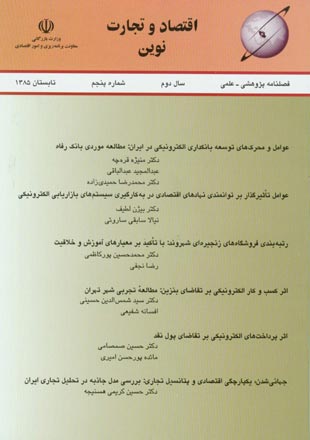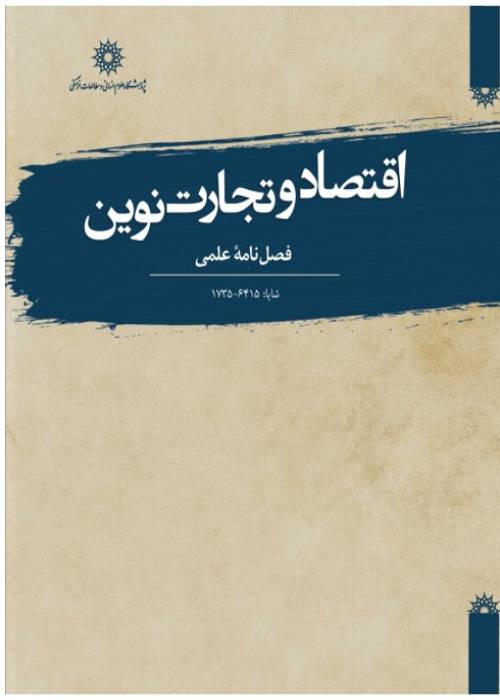فهرست مطالب

نشریه اقتصاد و تجارت نوین
سال دوم شماره 1 (پیاپی 5، تابستان 1385)
- 150 صفحه، بهای روی جلد: 10,000ريال
- تاریخ انتشار: 1385/05/10
- تعداد عناوین: 8
- مقالات
-
صفحه 1این مقاله عواملی که به عنوان محرک، توسعه رویکردهای بانکداری الکترونیکی را در سطح خرد اجتناب ناپذیر نموده، بررسی و تحلیل می کند. در این باره چارچوب و تصویر جامع از بانکداری الکترونیکی و رویکردها و عناصر اصلی زیربنای توسعه ارائه می شود و با تبادل نظر کارشناسان و متخصصان امور بانکی، تمامی عوامل و محرک های توسعه بانکداری الکترونیکی شناسایی شده و اهمیت نسبی هرکدام از این عوامل به عنوان دلایل راهبردی توسعه بانکداری الکترونیکی براساس تکنیک آنتروپی تعیین می شود. همچنین به دلیل نیاز صنعت بانکداری کشور در هماهنگی با موسسات و بانک های...
کلیدواژگان: بانکداری الکترونیکی، تجارت الکترونیکی، محرک های توسعه -
صفحه 24برای نیل به بازاریابی الکترونیکی و تعیین عوامل تاثیرگذار بر توانمندی نهادهای اقتصادی در به کارگیری آن موارد زیر در نظر گرفته می شود: عدم شناخت توانمندی های لازم برای پیاده سازی و به کارگیری فناوری اطلاعات- درک نادرست از زمان و مکان کاربرد فناوری در فرآیندهای کسب و کار- فقدان زیرساخت های سازمانی لازم برای استفاده از فناوری- سرمایه گذاری کلان بی برنامه در زمینه فناوری اطلاعات که گاهی منجر به ایجاد ارزش تجاری قابل قبول نمی شود و بازده مطلوبی عاید شرکت نمی گردد. تحقیق حاضر از نظر هدف تحقیقی کاربردی است که در جمع آوری اطلاعات...
کلیدواژگان: بازاریابی الکترونیکی، زیرساخت فناوری اطلاعات، همراستایی استراتژیک، اخذ و نفوذ فناوری اطلاعات، پذیرش فناوری اطلاعات -
صفحه 50ارزیابی و رتبه بندی صحیح فروشگاه ها همواره به عنوان سنجش عملکرد خرده فروشی ها به ویژه فروشگاه های زنجیره ای مطرح بوده است با استفاده از نتایج آن مدیران به راحتی می توانند به سنجش عملکرد دست یابند و تصمیمات مهمی مانند بسط و گسترش فروشگاه ها اولویت بندی و محک زدن ارتقا و بهبود کارایی کارکنان و... را اتخاذ کنند و درصدد شناسایی و رفع اشکالات برآیند. برای دستیابی به این امر در این مقاله که برگرفته از تحقیقی است ابتدا با انجام مطالعات کتابخانه ای و میدانی معیارها و عوامل کیفی و کمی در ارزیابی عملکرد مدیریت فروشگاه های زنجیره ای...
کلیدواژگان: رتبه بندی، فروشگاه های شهروند، سنجش عملکرد، معیارهای اقتصاد نوین -
صفحه 77مطالعه حاضر با پرداختن به مسئله تقاضای بالا برای بنزین و تبعات نامطلوب ناشی از آن به بررسی راهکارهای مختلف کاهش تقاضا برای این فرآورده می پردازد. راهکارهای آن با توجه به این واقعیت که تقاضا برای بنزین مشتق از تقاضای افراد برای سفر است در دو گروه سیاستگذاری کلی ارزیابی می شوند. راهکارهای گروه اول اشاره به سیاست های تحدیدی دارد که در آن تقاضا برای سفر افراد را محدود می کندو به طور عمده از سیاست های قیمتی و اعمال برخی مقررات خاص استفاده می شود. راهکارهای گروه دوم برکاهش نیاز به سفر متمرکز است و در آن به کاربردهای فناوری...
کلیدواژگان: کسب و کار الکترونیکی، تجارت الکترونیکی، تقاضای سفر، تقاضای بنزین -
صفحه 102هدف مقاله حاضر مطالعه اثر روش های مختلف پرداخت های الکترونیکی بر تقاضای پول نقد است. این اثر با استفاده از آمارهای سری زمانی و همچنین اطلاعات نه کشور طی سال های 1995-2005 به صورت تجربی برآورد و مورد آزمون و ارزیابی قرار می گیرد. مدل تقاضای پول نقد در این پژوهش به دو روش پنل دیتا و روش الگوی خود بازگشتی با وقفه های توزیع شده برآورد می شود. نتایج نشان می دهند نرخ سود تعداد دستگاه های pos و کارت ها تقاضای پول نقد را کاهش و تعداد دستگاه های atm و درآمد تقاضای پول نقد را افزایش می دهند.
کلیدواژگان: پرداخت های الکترونیکی، تقاضای پول نقد، داده های پنل -
صفحه 118این مقاله پس از ارائه حجم جریانات دو طرفه تجاری، موضوع یکپارچگی اقتصادی را به عنوان یک فرصت در قالب اقتصاد جهانی با استفاده از مدل جاذبه بررسی و تحلیل می کند. مدل جاذبه نیز با استفاده از داده های بین المللی سالانه 1994 تا 2005 با روش داده های پنل، برآورد می شود تا ضمن در نظر گرفتن اثرهای انفرادی مربوط به کشورهای عضو جریانات تجاری دو جانبه کشور ایران برای حضور در یکپارچکی اقتصادی شورای همکاری خلیج فارس و یکپارچگی کشورهای حوزه اقیانوس هند مورد تخمین واقع شود و پتانسیل تجاری دو جانبه کشور ایران برای حضور در مورد یکپارچگی اقتصادی...
کلیدواژگان: جهانی شدن، یکپارچگی اقتصادی، مدل جاذبه، پتانسیل تجاری دو جانبه ایران، داده های پانل -
راهنمای نویسندگانصفحه 144
-
چکیده انگلیسیصفحه 2
-
Page 1The emergence of electronic banking has been a topic of increasing interest for both academics and practitioners, in recent years as the changes taking place in the field are clearly observable. The reasons behind the success of electronic banking are complex. It is clear that banks activities alone may not be sufficient in achieving growth if general infrastructure, economic environment and government initiatives are not supportive. In this article the driving factors which affect the development of electronic banking in micro level are investigated. The necessary data are gathered through a survey conducted among the bank experts and interviews conducted with the leading banking professionals and experts and then the Entropy technique is employed to identify the relative importance of each factor affecting the development of electronic banking. Increased comfort and saving of time, reduced costs in accessing and using banking services, convenience, improvement of competitiveness, access to the new market, and electronic commerce development are empirically identified as the driving factors of developing electronic banking in micro level.Keywords: Electronic Banking_e_Commerce_Drivers of e Banking Development
-
Page 24In order to achieve e-Marketing and determine the factors affecting the capability of businesses in using e-Marketing systems, the following factors are taken into consideration: •Lake of required ability in launching and using information technology •Misunderstanding of time and place of using technology in business processes •Lake of sufficient infrastructures in using technology This paper is used survey method to gather data. More specifically, the data are collected by a questionnaire and then the data are analyzed using factor analysis. The findings show six factors affect the capability of businesses using e-Marketing. These factors which ranked based on the importance are as follows: •Soft infrastructure (human capital) •Financial management of processes •Hard infrastructure (Informational technology) •Electronic market-orientation •Behavioral acceptance of informational technology in e-Marketing •e-Marketing experienceKeywords: e, Marketing, IT Infrastructure, Acceptance, Strategic Alignment, IT Adoption, diffusion
-
Page 50In this paper, we develop a set of qualitative and quantitative criteria (financial performance, customer satisfaction, staff satisfaction) for evaluating and ranking the Shahrvand chain stores. Furthermore, the new economy criteria such as training, creativity and innovation are considered in the efficiency evaluation of the Sharvand Chain Stores. The information and data are collected by questionnaires, and interviews with the managements and professionals of the stores. Analytic Hierarchy Process (AHP) method which is composed of several unassociated concepts and techniques, such as, hierarchical structuring of complexity, pairwise comparisons, redundant judgments, an eigenvector method for deriving weights, and consistency considerations is used. Furthermore, Technical for Order Preference by Similarity to Ideal Solution (TOPSIS) method is employed to rank the stores. Its basic approach is to find an alternative which is closest to the ideal solution and farthest to the negative ideal solution in a multi-dimensional computing space. This multi-dimensional computing space is specified by a set of evaluation criteria as dimensions. The ideal solution represents a virtual alternative with a set of possibly best synthetic scores in terms of each criterion, while the negative-ideal solution is a virtual alternative with a set of worst scores. The findings show that out of eight stores, the Azadegan and Baharan Stores are respectively ranked to be the first and the last stores.Keywords: Chain Stores, AHP, TOPSIS, Training, Creativity, Iran
-
Page 77In the world of information technology, extraordinary innovations over the past decade are changing everything, especially business. These new technologies enable innovation in business methods, learning, health care and countless other aspects of society. Understanding the sensitivity of gasoline demand to innovation in business methods such as Electronic Commerce and Telecommunications (EC/TC), Tele-working, e-Learning and etc. has important implications for policies. This study aims to examine the effects of e-Business in reducing gasoline demand in Tehran. The gasoline demand is derived from the demand for trip. There are two approaches to reduce the trip. The first approach refers to restrict the trip. So, the demand for trip is reduced by price policies or regulations. In contrast, the second approach emphasis on the reduction of the trip by using EC/TC, tele-working, e-Learning and etc. Considering the objective of the study, the second approach is used to analyze the effects of innovation on trip and them gasoline demand. The results of this research suggest that 10 percent increase in EC/TC, the gasoline demand will decrease by 5 percent. Therefore, the development of Electronic Commerce should be regarded as an important approach in the country's optimizing fuel consumption plans.Keywords: e, Business, EC, TC, Gasoline Demand, Iran
-
Page 102The costs of using electronic payment instruments have to be lower than the paper-based instruments and so, there has been a tendency to shift to the use of a relatively more cost effective type of payment instruments in many countries. In this regard, it is interesting to see whether, and to what extent, such a changing payment landscape toward the greater use of electronic payments is of particularly successful to the case of retail payment system in Iran. More specifically, this paper analyzes how credit card, POS payments and ATM withdrawals affect cash demand. In this study, two methods are employed to estimate the model. They comprise Autoregressive distributed lag (ARDL) and panel data methods. We estimated the effects of different electronic means of payment on demand for cash using 1995–2005 panel data for Iran and other nine countries and also time series data over the period 1981–2004 for Iran. The results confirm that the number of POS and interest rate have negative effect and the number of ATM and income have positive effects on the demand for cash.Keywords: Electronic Payment instruments, Demand for Cash, Panel Data
-
Page 118The purpose of this paper is to empirically analyze Iran's trade patterns based on the gravity model and to suggest possible ways to expand trade by identifying important factors determining Iran's bilateral trade flows. This study will, in particular, look at the influence of the bilateral trade structures and regional economic blocs on Iran’s bilateral trade flows with special focus on the Persian Gulf countries, and countries of the Indian Ocean. This study uses the data which include bilateral flows of Iran's trade with the Persian Gulf countries and countries of the Indian Ocean over the period 1994-2005. The panel date approach is employed to estimate the augmented gravity model. The model adds a certain number of dummy variables to the original gravity equation that test for specific effects. According to the regression results of the analysis, trade potential increases Iran's trade with the Persian Gulf countries, and countries of the Indian Ocean by 5 and 25 percent, respectively.Keywords: Globalization, Economic Integration, Gravity Model, Bilateral Potential Trade Flows, Panel Data


